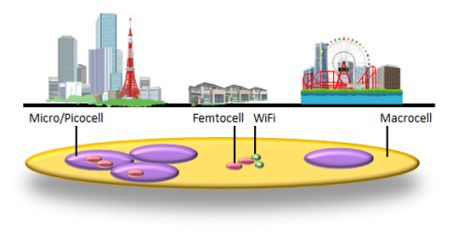Heteregeneous network
|
Heterogeneous networks (HetNet) is a term used for modern mobile communications networks. A modern mobile communications network is comprised of a combination of different cell types and different access technologies.
A typical HetNet uses a combination of legacy systems (e.g. GSM en UMTS) and modern radio access technologies such as LTE, possibly completed with Wi-Fi.

|
| Architecture of a HetNet (© NEC). |
Macro cells are used to provide coverage. Pico cells and micro cells are used to enhance capacity in busy areas, such as train stations, shopping malls and city centers. Femto cells and Wi-Fi are used at the office and at home. Deployment of these small cell are a key feature of the HetNet approach as they allow considerable flexibility as to where they are positioned. Wi-fi can play a significant role in HetNets, both in terms of data offload and in terms of roaming, especially between an outdoor environemt and an in-house environment.
Operators can potentially provide a more consistent customer experience compared to what could be achieved with a homogenous network, by integrating a variety of technologies and cell layers depending on the topology of the coverage area. A seamless transition between the different layers and different radio interfaces takes place, without requiring the user to do anything.